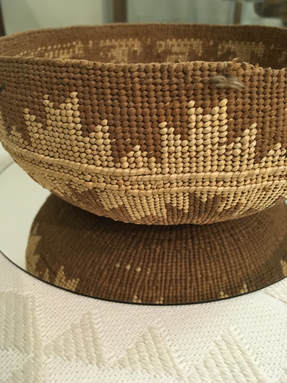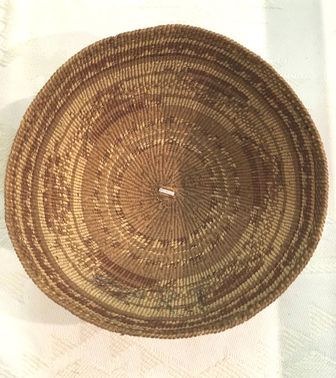Sípnuuk'anamahach (Karuk, lit. little storage basket), je:lo’ch (Hupa lit. storage basket (diminutive)), tswachach (Wiyot, small twined trinket basket), perhcherkws (Yurok, showy basket, basket for valuables)
From Pi’êep Káru Payêem—Long Ago and Today: Exhibition of Karuk Arts, 2012 exhibition catalog by Julian Lang:
"Sípnuuk is the Karuk word used to designate a trinket basket. These are finely woven baskets, most often round and some are lidded, though most are not, and are usually by weavers as gifts to be used to hold valuables such as dentalia and the like. As with caps the greater the number of stitches the more prized the sípnuuk became.”
Baskets made for the trade, showing European influences of form yet maintaining a foundational Indigenous design aesthetic are far more than is regularly seen on the shelf. These baskets are woven with design work from bottom to top, sometimes even having designs inside the basket either placed there or the exterior designs showing through due to the weaving process.
"Sípnuuk is the Karuk word used to designate a trinket basket. These are finely woven baskets, most often round and some are lidded, though most are not, and are usually by weavers as gifts to be used to hold valuables such as dentalia and the like. As with caps the greater the number of stitches the more prized the sípnuuk became.”
Baskets made for the trade, showing European influences of form yet maintaining a foundational Indigenous design aesthetic are far more than is regularly seen on the shelf. These baskets are woven with design work from bottom to top, sometimes even having designs inside the basket either placed there or the exterior designs showing through due to the weaving process.
| A lidded trinket basket, seen here to the left, from 1920, woven by an unknown Yurok weaver, is adorned with a Morningstar design on the body of the basket, hides an interesting base. The flower design around the start of the basket at the base is trimmed in skip-skip design (alternating maidenhair fern and Beargrass) that is repeated and echoed at the rim and on the lid. The next basket was woven by an unknown Karuk weaver c. 1940. Seeing baskets covered in maidenhair fern is always a treat. This delicate fern overlay shows the expertise of the basketweaver and her steady hand at working with such a fragile material, as well as highlighting whatever design is woven into the basket, usually in porcupine quills or like here in beargrass. |
The bottom hides a surprise of beautiful even weaving with plain spruce root. The pattern of the weaving creates a beautiful texture moving from the button or start of the basket’s parallel weaving lines to a triple weave of twining where she worked with three weavers at a time. From there she began a double weave, where she wove around two sticks at a time, creating this brick-like pattern radiating from the center. Finally meeting the body of the basket where she turned the sticks up and started her overlay pattern with maidenhair fern. This is a lovely basket with design as frog’s hand done in Beargrass on the black maidenhair background with a trim of alternating beargrass/maidenhair fern skip-skip design.
When looking to insides of baskets sometimes you can see the design of the basket through the wall of the basket clearly much like some other textile processes. The interior of this basket cap, woven by Madeline Davis, a Karuk weaver, around 1930, shows a reverse of its exterior design. This is due to the weaving process where normally the overlay material (fern, beargrass, etc.) would be on the outside of the weaver (weft). The general way of weaving would be to snip this off when that overlay is no longer needed in the pattern. Here it is slipped to the inside of the weaver (weft) so that it shows through to the interior. This is generally seen as an older way of weaving, or some sources note this is a Karuk style of weaving.
 Twined men’s eating bowl. Unknown Yurok weaver. c. 1918. beargrass, spruce roots and hazel sticks. "To point" design. Worthington Collection. Acc#: B60.046.118
Twined men’s eating bowl. Unknown Yurok weaver. c. 1918. beargrass, spruce roots and hazel sticks. "To point" design. Worthington Collection. Acc#: B60.046.118 Finally, this men’s eating basket/bowl from 1918, made by an unknown Yurok weaver has a small point of interest just along the underside of the basket.
We don't know the identity of the weaver, but the four stitches of beargrass overlay in a field of woven spruce roots is the intentionality of a signature.
Many weavers would leave signatures like this in their baskets, but the identities of the weavers and the people who could interpret what the signatures mean have passed on.
The majority of the time we will see these baskets displayed but won’t know what the bottom of the basket actually looks like, or the interior is hidden from view. With trinket baskets especially, we are missing really lovely moments that tie in to the overall design work of the basket.
Some have surprising design choices that differ from the main design theme. Make sure to take a second look at the baskets in these cases, they are showing lovely moments that otherwise would be missed.
We don't know the identity of the weaver, but the four stitches of beargrass overlay in a field of woven spruce roots is the intentionality of a signature.
Many weavers would leave signatures like this in their baskets, but the identities of the weavers and the people who could interpret what the signatures mean have passed on.
The majority of the time we will see these baskets displayed but won’t know what the bottom of the basket actually looks like, or the interior is hidden from view. With trinket baskets especially, we are missing really lovely moments that tie in to the overall design work of the basket.
Some have surprising design choices that differ from the main design theme. Make sure to take a second look at the baskets in these cases, they are showing lovely moments that otherwise would be missed.






 RSS Feed
RSS Feed